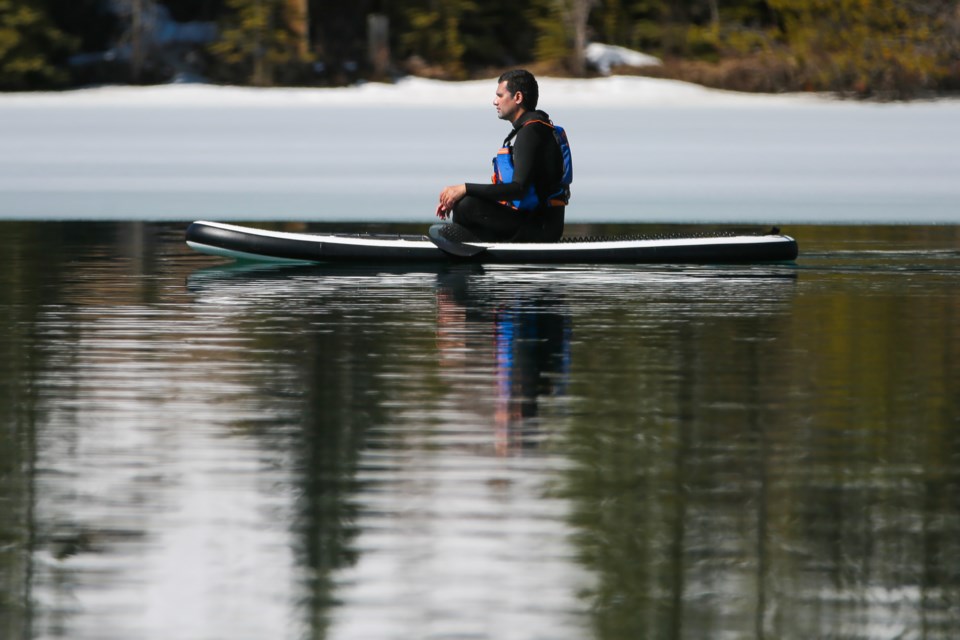CANMORE – Canmore has been one of the leading municipalities in Alberta when it comes to taking action for climate change.
And in an update to council, a laundry list of positive results were on display of what has been achieved locally when it comes to the Town’s role.
Whether it is through reducing emissions, enabling other forms of non-vehicle transportation or focusing on alternative sources of energy, the first steps have led to results.
The Town’s energy and climate action coordinator, Amy Fournier, noted at council’s committee of the whole meeting climate action is spread throughout the municipality, such as giving more non-vehicle options for transit.
“One important strategy in reducing [greenhouse gas] emissions through transportation is shifting trips from vehicles into sustainable methods like walking, cycling and public transit. Having great infrastructure is an important part of this,” she said, with 80.4 kilometres of paved and unpaved paths available.
Infrastructure projects that have prioritized alternative transit methods, such as in the Spring Creek area, and enabling free local transit, have aided residents and visitors getting around.
Fournier called the free local transit component “the envy of municipalities everywhere,” with it reducing a barrier to push people to use the service.
She highlighted how the Town’s studded tire incentive program – first piloted in 2019 – had 50 incentives doled out in the first six days, helping people consider winter cycling.
The guiding principles for climate action by the Town began in 2010 with the Environmental Sustainability Action Plan and then the Climate Adaptation and Resilience Plan in 2016.
The climate action plan was created in 2018 and Canmore council declared a climate emergency in 2019.
Town council put further emphasis on reducing greenhouse gas emissions in its 2019-22 strategic plan.
The established goals aim to reduce greenhouse gas emissions in municipally owned buildings by 50 per cent by 2030 and 80 per cent by 2050.
In the rest of the community, the goals are a 30 per cent reduction by 2030 and 80 per cent by 2050.
Lori Rissling Wynn, the environment and sustainability supervisor for the Town, told council data shows roughly 34 per cent of greenhouse gas emissions in the community come from transit, 33 per cent from commercial and institutional buildings,
26 per cent from residential buildings and seven per cent from waste.
She said about 266,000 tonnes of carbon dioxide come from those categories, of which four per cent are from municipally owned buildings, noting they’re focusing on waste reduction, low carbon transit, renewable energy and energy efficient buildings to reduce emissions.
Elevation Place, Rissling Wynn said, was a fantastic example of reducing emissions on municipally owned buildings.
She also pointed out the recently approved net zero carbon fire hall will further help the Town achieve its goals.
The clean energy improvement program will be unveiled later this year to help finance costs for residential properties, Rissling Wynn added.
The Town also has a solar incentive program, with 57 homes, one school and one business participating since it was launched in 2014.
“It shows people it is possible to do solar here in the community, and neighbours are talking to neighbours about solar installation and it’s really taken off since it began,” Rissling Wynn said.
The program has cost the Town $61,500, but 429 kilowatts of capacity have been installed.
Each year since 2014, the amount of solar photovoltaic capacity in Canmore has grown from less than 50 to about 1,300 at the end of 2020.
“It’s quite significant for a town of our size,” Rissling Wynn said.
The neighbourhood bin organic diversion pilot program has seen 11 per cent of resident food waste diverted from the local landfill, with food waste occupying roughly 30 per cent of the landfill, Fournier said.
Fournier also added the program will see 10 new bins added throughout town before the end of the year, while the new commercial food waste collection program having been launched in January.
“Residents are amazing at diverting,” Fournier said.
“They are really doing a great job.”
Both Rissling Wynn and Fournier said a key aspect of success is engaging all partners in working towards the ultimate climate action goals.
“If somebody had said 10 years ago these are all the things that will happen in the Town of Canmore, I don’t think so,” Mayor John Borrowman said, noting what had been accomplished.
“A lot of work has been done and kudos to everyone. … I’m astounded in what’s been done in 10 years.”







